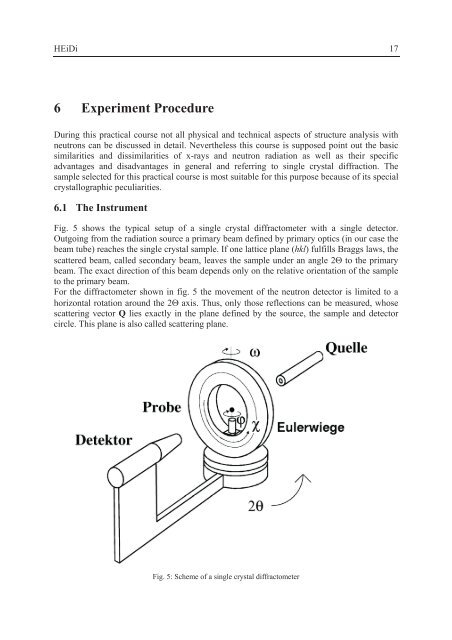Neutron Scattering - JUWEL - Forschungszentrum Jülich
Neutron Scattering - JUWEL - Forschungszentrum Jülich
Neutron Scattering - JUWEL - Forschungszentrum Jülich
Create successful ePaper yourself
Turn your PDF publications into a flip-book with our unique Google optimized e-Paper software.
HEiDi 17<br />
6 Experiment Procedure<br />
During this practical course not all physical and technical aspects of structure analysis with<br />
neutrons can be discussed in detail. Nevertheless this course is supposed point out the basic<br />
similarities and dissimilarities of x-rays and neutron radiation as well as their specific<br />
advantages and disadvantages in general and referring to single crystal diffraction. The<br />
sample selected for this practical course is most suitable for this purpose because of its special<br />
crystallographic peculiarities.<br />
6.1 The Instrument<br />
Fig. 5 shows the typical setup of a single crystal diffractometer with a single detector.<br />
Outgoing from the radiation source a primary beam defined by primary optics (in our case the<br />
beam tube) reaches the single crystal sample. If one lattice plane (hkl) fulfills Braggs laws, the<br />
scattered beam, called secondary beam, leaves the sample under an angle 2� to the primary<br />
beam. The exact direction of this beam depends only on the relative orientation of the sample<br />
to the primary beam.<br />
For the diffractometer shown in fig. 5 the movement of the neutron detector is limited to a<br />
horizontal rotation around the 2� axis. Thus, only those reflections can be measured, whose<br />
scattering vector Q lies exactly in the plane defined by the source, the sample and detector<br />
circle. This plane is also called scattering plane.<br />
Fig. 5: Scheme of a single crystal diffractometer

















